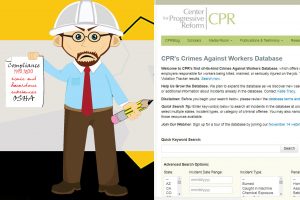The Center for Progressive Reform (CPR) launched a first-of-its-kind database on Oct. 30. The Crimes Against Workers Database contains detailed information on criminal cases where workers have been seriously injured or killed as a result of a workplace accident.
After any incident, OSHA assesses infractions and levies fines against each employer and, in most cases, district attorneys will leave the consequences up to the administration. However, in some cases, criminal charges are pursued. Katie Tracy, CPR’s policy analyst and database project lead, explained that OSHA penalties alone are not enough to hold guilty employers accountable.
“Every state has laws on the books that allow for criminal prosecution of employers who cause a worker’s death or serious injury,” Tracy said. “Our database highlights instances in which states have pursued such cases over the past several decades to seek justice for workers and their families and to hold employers responsible for their actions. Until now, such information has been scattered across the Internet and not terribly useful to advocates and researchers.”
The database details past and current cases with a variety of materials, including: Case files, advocacy resources, and video clips. Currently, there are 76 incidents on file that span across 16 states. Nine of those 76 incidents are due to chemical exposure which resulted in health issues and/or death.
(Related Article: Fine-Abatement Method: OSHA’s Solution to Lead Poisoning)
California Lead Poisoning Case
A Los Angeles metal company was cited by OSHA after failing to provide medical examinations to five employees with high lead blood levels. The leadership team failed to take the recommendations of the company physician, insisting that lead level was under the federal exposure limit, when, in fact, it was 30 times higher.
As a result, several employees suffered from lead poisoning. They attempted to pursue a criminal trial against the company, its president, and their plant manager. Instead of going to trial, the company paid $25 thousand in OSHA penalties and fines, and made a contribution of $200 thousand to finance a new occupational lead-screening program in Los Angeles County.
Hydrogen Sulfide Gas Poisoning
Another incident in the database shows that, sometimes, criminal cases against employers are successful. Two employees of a Yuma sewer company died as a result of acute hydrogen sulfide gas poisoning while working in an underground sewer tank. The exposure to the gas caused them both to lose consciousness, and inevitably drown in the sewage. As per the report, the company lacked critical safety equipment required for confined space entry; did not use or require air monitoring or blower equipment; and did not provide employees with hazard safety training.
Furthermore, the company lacked rescue equipment, and made no attempt to identify rescue services. Thus, another employee suffered severe, life-threatening injuries, including respiratory distress syndrome and aspiration pneumonia, while attempting to rescue the others.
An OSHA report from an inspection conducted six months prior to the incident revealed that the company was required to obtain permit space procedures and training. It also specified that the company was to also procure necessary safety equipment. Unfortunately, those actions were not taken.
A criminal court found the company, its president, and the job foreman guilty of manslaughter, aggravated assault, and endangerment. as a result, the company was fined $1.77 million. It was also required to implement new health and safety programs, and to pay $156,425 in restitution. The president was sentenced to seven years of supervised probation, 840 hours of community service served in safety training classes, and a $50,000 fine. The foreman served one year of probation.
Moving Forward
“Thousands of workers will die on the job this year, and a vast majority of those deaths are avoidable,” CPR Executive Director Matthew Studtz said. “The threat of criminal charges sends a strong message to scofflaw employers – your own fate is on the line when you put your workers at risk.”
The best way for employers to avoid fines and charges is to stay vigilant with the health and safety of their employees. Those who do not are putting their companies, and their team members’ lives in danger.
Are you in compliance?
Schedule Your Medical Surveillance Testing Today!
Schedule Your Medical Surveillance Testing Today!





